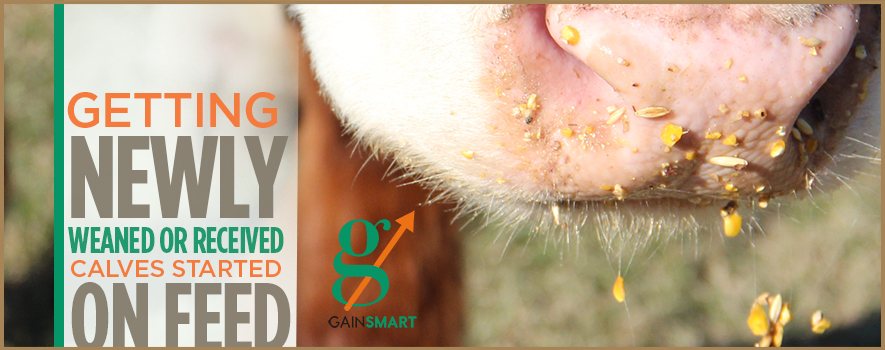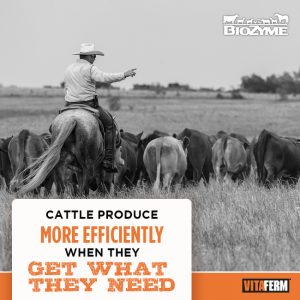
Article courtesy of Dr. Brandi Karisch, Mississippi State University
A goal of any receiving or weaning plan should be to minimize stress on newly received calves. Starting new cattle, whether they be newly weaned or freshly received into a stocker operation, can often be a challenge. A goal of any receiving or weaning plan should be to get calves started on feed quickly and eating well. Management of their diets can have long term impacts on performance.
The receiving phase offers unique nutritional challenges as compared to other phases of a calf’s life. Proper nutritional management during this phase is critical to ensuring success and profitability. These calves are often stressed upon arrival or after weaning, and will likely have low feed and water intake for several days. Some calves may even be naïve to feed, hay, or even water troughs, and calves should be carefully observed during this time. Due to their often low feed intake, receiving diets should be formulated to be highly palatable, stimulate intake, and provide a more concentrated source of key nutrients.
Some guidelines to follow include:
1. Provide access to clean fresh water: Water is an essential nutrient, and should be readily accessible. Be sure that water troughs are free of mold and algae growth. Consider the fact that calves may be accustomed to drinking from ponds or streams, and may not immediately recognize an automatic waterer.
2. Provide access to free choice hay: Calves will likely be able to easily recognize and consume hay. They should have access to good quality grass hay to stimulate proper rumen function.
3. Provide palatable feed with greater concentrations of nutrients: On average, feed intake of newly received calves is low. Because of this, diets for calves starting on feed should be formulated both to maximize intake and provide greater concentrations of required nutrients. Receiving diets must be highly palatable, stimulate intake, provide acceptable levels of critical nutrients, and minimize the potential for nutritional disorders. Generally, receiving diets containing more than 55 percent concentrate can lead to digestive problems, resulting in higher medication costs.
4. Formulate diets based on age and size of calf: Diets should be formulated so the calf receives at least maintenance requirements for protein, vitamins, and minerals when feed consumption is 1.0 to 1.5 percent of body weight. Lightweight (350 pounds or less) and early-weaned (weaned at or before four months of age) calves may need more nutrient dense diets than larger, later-weaned calves. These lighter calves require a higher percentage of protein and a good source of digestible energy in their diets than do larger calves.
5. Be mindful of protein source: The source of protein is also critical in receiving diets. Non-protein nitrogen (urea) is not recommended in receiving diets for calves less than 600 pounds and should be avoided altogether for feeding lightweight calves. Plant protein sources such as soybean meal, cottonseed meal, and alfalfa are acceptable protein supplements for these calves.
6. Offer a good quality mineral: Providing proper mineral supplementation is an essential component of a good nutritional program for calves. Phosphorus levels are typically low on forage-based diets, so next to sodium and chloride, phosphorus is a key mineral to supplement to balance the diet. Trace minerals such as zinc and copper, along with vitamins A and E, are also important in meeting the nutritional needs of calves.
7. Place feed and water along the boundaries of pens: Calves initially walk the boundaries of their new pens searching for a way to escape. Placing feed bunks and water troughs along the fence lines of receiving pens, as opposed to in the center of the pens, increases the frequency of calves’ walking past the bunks and troughs.
8. Provide adequate feed bunk and water trough space: Timid calves may not receive sufficient shares of feed if bunk space is limiting. At least 12 linear inches of bunk space per head is recommended for incoming cattle. A good guideline is to provide 18 to 24 linear inches of bunk space per calf.
9. Be consistent with feed deliveries: Feed cattle approximately the same time each day to establish a routine, consistent eating time. Twice-a-day feedings can be worthwhile the first two to three weeks of the receiving period for highly stressed, young, or lightweight cattle. Sick calves may be slow to come to the feed bunk, so it is useful to observe feeding behavior to help identify potential health problems.
Thoughts from BioZyme Director of Nutrition & Technical Sales, Kevin Glaubius
As the article above points out, there is a lot that producers can do from a management perspective rather than just going through the process. To be successful make a checklist of the nine bullet points above. BioZyme offers an outstanding product line for weaning including our Vita Charge products available in seven different formulas giving you the flexibility of administering chute side or feed choice. In addition to a powerful does of vitamins and B vitamins, Vita Charge contains AMAFERM, is a prebiotic designed to enhance digestibility by amplifying the nutrient supply for maximum performance. It is research-proven to increase intake, digestion and absorption.
On arrival we recommend starting with with the Vita Charge® Gel or drench then offer the Vita Charge Stress Tub for the first 14-28 day. The benefit of the stress tub is you can place these around the pen and the calves will consume them even before they find the bunks. This helps jump start appetite and mineral nutrition ensuring a successful program and gives calves a head start the first week or two over products fed in the bunks. In the bunk, we recommend offering Gain Smart Stocker mineral as part of the TMR, grain mix or with the mineral free choice.
Our nutritionists would be happy to assist you in formulating the right ration along with forage testing to ensure the calves are receiving the proper nutrient dense diet for a healthy sure start this weaning season.


